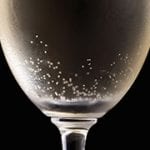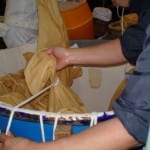 Al Gizzi likely never thought his legacy would live on in quite this way. And he surely never considered that he would be associated with sake. Al Gizzi does not even likely remember me.
Al Gizzi likely never thought his legacy would live on in quite this way. And he surely never considered that he would be associated with sake. Al Gizzi does not even likely remember me.
Al Gizzi, or “Gizz-balls” as he was known behind his back in his less popular moments, was my high school football coach. He was also an English teacher, and his love for literature lent him a leaning toward alliteration that bled into his coaching efforts.
On that high school team, I was fortunate enough to have played offensive guard, where protecting the quarterback is paramount. When he drops back for a pass, we offensive linemen were taught by Coach Gizzi to take the impact of the defensive rush, and “give ground grudgingly,” referring to how we would slowly yield petite portions of the pitch, backing up to form a pocket from which the quarterback could find his receiver way down field. Give ground grudgingly. Succinct yet thorough, these words described our ideal movements perfectly.
Our team never went anywhere, although we did manage to finish a respectable 7-3, and my football career came to an abrupt if predictable halt upon my graduation from that esteemed institution. But Gizz-balls’ words have remained with me over the years.
What, pray tell, does this have to do with sake? By all means, read on.
As sake continues to grow in popularity, a handful of hitherto peripheral types of sake are getting dragged into the fringes of our collective attention. I am referring to things like sparkling sake, low alcohol sake, and even high alcohol sake. Then there are things like aged sake, kijoushu, taru-zake, and red sake. And, of course, there is that bane of my existence, sake cocktails. (It hurts my fingers to type those two words on the same page, much less in the same sentence.)
But, alas, when confronted with these less-than-orthodox types of sake out there, the handful of funky variations made using one whacky ingredient or method that surely has the toji of bygone years spinning in their graves, I have come to the realization that it is time to “Give Ground Grudgingly.”
Yes, it may be time for me to acknowledge that these types are out there, and that there may even be people that like them and want to drink them. With just a vestigial hint of a Grudge remaining, the time has come to Give Ground, recognize and even endorse these for the benefit of those that do or might enjoy them.
Why have I been so reticent to do this until now? A number of reasons, most of them centered around my intention to convey good, useful information about sake.
I am personally most fond of “orthodox” styles of sake. What is orthodox? Like, you know, regular stuff.
Fairly youthful, not sparkling, not cloudy, not red, not unusually high or low in alcohol, and not mixed with anything else. And there are plenty of these, from all walks of sake, including dry, heavy, sweet, light, aromatic, subdued, subtle, lively, soft, tart, thick, airy, smooth, textured and including every permutation of these and everything in between. There is such diversity within this realm of “normality” that it could never come to be considered mundane.
But as I pointed out, it is much, much more than just a matter of my personal preferences. It seems best to convey to those interested in sake just where the best of sake is to be found. And it tends to be more in standard sake than in the fringe-dweller sake.
Not that I am dissing these novel types. Not at all; really. It is all about enjoyment in the end, and if you like them, end of story. But if you want to know where the best of sake is to be found, the culmination of centuries of honed skills combined with modern technology, unique, artisanal sake, and if you want to enjoy sake that you know will be a viable product and part of the market as well as a dependable connoisseur product for years to come, drink the afore-defined orthodox stuff.
Actually, anomalies and variations are good, fine and useful. They keep the category interesting, let brewers push the envelope a bit, and ensure that in the sake world there is a little something for everyone out there. But it is important to have a firm grounding in orthodox stuff too. And it is important to keep such diversions just that: paths off of the main road of premium sake.
So indeed, creativity and innovation are cool and to be respected, and in fact are indispensable to the survival of anything. Which is one of the reasons I am giving ground grudgingly to their admittedly rightful place in the market.
Here is a rundown of the rogue types; hitherto offenders, henceforth contenders.
Sparkling sake
Perhaps the fastest growing of these new types, there are two main types of sparkling sake out there. One, like champagne, sees a secondary fermentation in the  bottle. Another is made by jacking sake with carbon dioxide. Everything in the Universe has a price, and this includes bubbles in your sake. That price is paid from the coffers of flavor. Much of this sparkling sake has an alcohol content of about eight percent, yet others are up around 14 percent. To me, it generally tastes like spiked cream soda; it is just the size of the spike that differs. But admittedly cream soda has its appeal too, and sparkling sake can be very drinkable.
bottle. Another is made by jacking sake with carbon dioxide. Everything in the Universe has a price, and this includes bubbles in your sake. That price is paid from the coffers of flavor. Much of this sparkling sake has an alcohol content of about eight percent, yet others are up around 14 percent. To me, it generally tastes like spiked cream soda; it is just the size of the spike that differs. But admittedly cream soda has its appeal too, and sparkling sake can be very drinkable.
Red sake
There are several ways to make sake that is reddish in tint, a pigment that often approaches rose wine. Most common among the few of these that is exist is using red rice strains.
Low alcohol sake
A few brewers have come out with sake that is only eight to 12 percent alcohol, jacking up the acidity quite a bit to provide punch. The thinking is that some folks cannot handle a full 16 percent, so these products would appeal to them. The ones that are out there are, for the most part, balanced and enjoyable, if different from regular sake.
High alcohol sake
The newest of the brat pack here, there are a couple of sake with an alcohol content of 25 percent or more, even one at 38 percent. Note, these are NOT distilled. However, yeast cannot survive above 20 percent alcohol or so. So how do they do it? They freeze it, using one method or another, and take out the ice, effectively removing water and increasing the final alcohol content.
 Kijoushu
Kijoushu
This type of sake is made with some of the brewing water replaced by already-brewed sake. Often, kijoushu is also aged for several years. While enjoyable, it is markedly different from orthodox sake, and very little of it is made.
Aged sake
Known as koshu (old sake), or more formally and eloquently as choki-jukusei-shu (long term matured sake), something about saying that old sake is new smacks of an oxymoron. Aged sake is a topic that deserves much more attention that just these scant few lines here. Nevertheless, very little is made and available, hence its relegation to outlier status. It can, in fact, be delicious and interesting.
Taru-zake
Taru-zake is sake that has spent a bit of time (from hours to weeks or longer) in a wooden cask made of cryptomeria, or sugi, also called Japanese cedar. This gives it a very pronounced woodiness to the aromas and flavors, to the degree that often that is all one can perceive. Which is great, if you like it.
Nigori
Nigori-zake is in fact filtered, even though many like to call it “unfiltered sake.” But it is filtered with a coarser mesh that lets some of the rice solids through. Chewy and rich, but hardly refined, it is much more popular overseas than in Japan.
Sake cocktails
There are those in the mixology trade that insist that sake is a great cocktail ingredient. I wouldn’t know. ‘Nuff said.
This is just a handful of the myriad variations out there. Heck, I just had a kijoushu taruzake the other day that was outstanding. So, let me reiterate that I am not anti- anything. I am more simply for good sake and its spreading popularity. And with sake just starting to really catch on outside of Japan, it seems best to remember where the essence great sake can be found; this makes the variations that much more enjoyable.
And so, from here on out, the time has come to Give Ground Grudgingly to the various manifestations of sake that are out there. Hopefully this will help to form a pocket from which that diversely talented quarterback of the sake world, orthodox premium sake, can launch a perfectly timed and placed touchdown pass and win over the world.
Al Gizzi would be proud.




